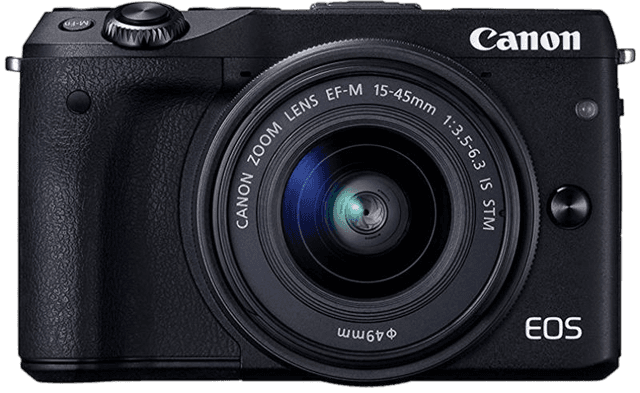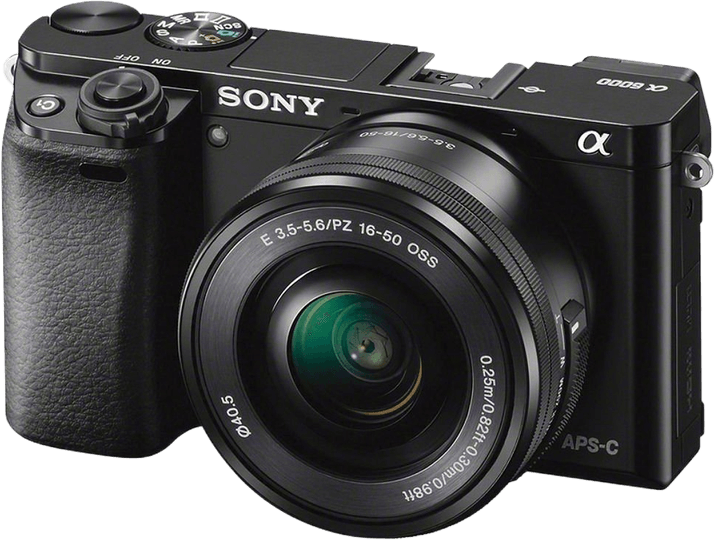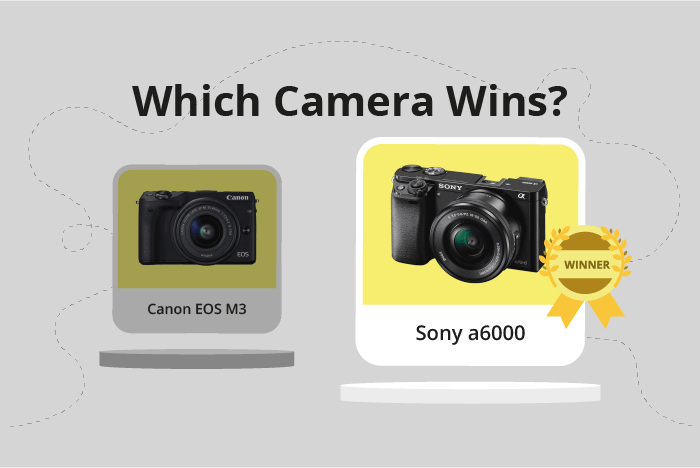Canon EOS M3 vs Sony a6000 Comparison
Canon EOS M3

Sony a6000

The Sony a6000 narrowly wins with a score of 57/100, compared to the Canon EOS M3‘s score of 56/100. Both cameras are mirrorless and share similar dimensions, with the Sony a6000 measuring 120 x 67 x 45mm and the Canon EOS M3 at 111 x 68 x 44mm. They also have comparable weights, with the a6000 at 344g and the EOS M3 at 366g.
The Sony a6000 stands out with its lower launch price of $799 compared to the Canon EOS M3’s $870. Furthermore, it was released a year earlier in 2014. On the other hand, the Canon EOS M3 has a slightly more compact design, which some users may prefer.
Taking all of these factors into consideration, the Sony a6000 edges out the Canon EOS M3 in terms of price and release date, while the Canon EOS M3 offers a more compact size. Both cameras have their strengths, and the choice ultimately depends on the user’s preferences and priorities.
Canon EOS M3 vs Sony a6000 Overview and Optics
The Sony a6000 emerges as the winner in the optics category, scoring 67 out of 100, which is a 7-point lead over the Canon EOS M3’s score of 60. Both cameras share several specifications, such as the 24-megapixel count, APS-C sensor size, CMOS sensor type, and lack of image stabilization. They also have different lens mounts, with the Canon EOS M3 using a Canon EF-M mount and the Sony a6000 using a Sony E mount.
The Sony a6000 excels in various aspects, such as its higher shooting speed of 11 fps compared to the Canon EOS M3’s 4.2 fps. This allows for capturing fast-moving subjects more effectively. Additionally, the Sony a6000 has a superior DXOMARK sensor score of 82, while the Canon EOS M3 lags behind with a score of 72. This difference indicates that the Sony a6000 has better overall image quality and low-light performance.
On the other hand, the Canon EOS M3 has a few advantages, such as its Digic 6 processor, which may offer better processing capabilities compared to the Sony a6000’s Bionz X processor. However, the advantages of the Canon EOS M3 are not significant enough to outweigh the benefits provided by the Sony a6000.
Considering the differences in optics performance, the Sony a6000 is the better camera. Its higher score reflects its superiority in shooting speed and image quality. While the Canon EOS M3 has some strengths, they do not compensate for its shortcomings in the optics category.
Canon EOS M3 vs Sony a6000 Video Performance
The Sony a6000 outperforms the Canon EOS M3 in video capabilities, with a video score of 56/100 compared to the EOS M3’s 43/100. Both cameras share some common video specifications, such as Full HD maximum video resolution and 1920 x 1080 maximum video dimensions. However, there are differences that make the Sony a6000 a superior choice for video recording.
The Sony a6000 has a higher maximum video frame rate of 60fps, while the Canon EOS M3 only reaches 30fps. This difference allows the a6000 to capture smoother and more detailed video, especially in fast-moving scenes or when shooting slow-motion footage. Additionally, neither camera has built-in time-lapse functionality, but both can achieve this effect with the use of external software or accessories.
While the Canon EOS M3 does not offer any distinct advantages over the Sony a6000 in terms of video capabilities, it is still a capable camera for casual video recording. Its Full HD resolution and 30fps frame rate are sufficient for most users who are not seeking professional-level video quality.
Considering the specifications and scores, the Sony a6000 is the better camera for video recording due to its higher frame rate, which results in smoother and more detailed footage. The Canon EOS M3, while not as strong in this area, remains a suitable choice for casual video users. Ultimately, the choice between these two cameras will depend on the specific needs and preferences of the photographer or videographer.
Canon EOS M3 vs Sony a6000 Features and Benefits
The Canon EOS M3 triumphs over the Sony a6000 in features, scoring 57 out of 100 compared to the Sony a6000’s score of 41. Both cameras have some common features, such as a 3-inch screen, flip screen, absence of GPS, and the presence of WIFI. However, there are a few key differences that make the Canon EOS M3 stand out.
The Canon EOS M3 has a higher screen resolution of 1,040,000 dots compared to the Sony a6000’s 921,600 dots. This higher resolution allows for clearer and more detailed image previews on the camera’s screen. Additionally, the Canon EOS M3 has a touchscreen, which makes navigating menus and adjusting settings faster and more convenient. The Sony a6000 lacks this feature.
While the Sony a6000 falls short in some areas, it matches the Canon EOS M3 in other aspects. Both cameras have flip screens, which make it easier to take selfies or capture shots from difficult angles. They also both lack GPS, which means neither camera can geotag photos without additional accessories. Additionally, both cameras have WIFI capabilities, allowing for easy sharing and transferring of images.
Despite the lower feature score, the Sony a6000 still has its merits. However, the Canon EOS M3’s superior screen resolution and touchscreen capabilities make it the better choice when comparing features. The additional convenience and functionality provided by these features may appeal to photographers looking for a camera with more advanced options.
Canon EOS M3 vs Sony a6000 Storage and Battery
The Sony a6000 outperforms the Canon EOS M3 in storage and battery with a score of 21/100, compared to the Canon’s 16/100. Both cameras share common specifications, such as having a single memory card slot and accepting SD, SDHC, and SDXC cards. However, the Sony a6000 also accepts Memory Stick Pro Duo and Pro-HG Duo cards, offering more storage options.
In terms of battery life, the Sony a6000 is superior with 360 shots per charge, while the Canon EOS M3 only provides 250 shots. Both cameras use different battery types, with the Sony a6000 using the NP-FW50 and the Canon EOS M3 using the LP-E17. Neither camera supports USB charging.
While the Sony a6000 holds an advantage in storage compatibility and battery life, the Canon EOS M3 does not offer any particular benefits in this comparison. Consequently, the Sony a6000 is the better choice for storage and battery capabilities.
Alternatives to the Canon EOS M3 and Sony a6000
Are you still undecided about which camera is right for you? Have a look at these popular comparisons that feature the Canon EOS M3 or the Sony a6000:

